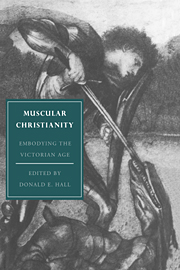Book contents
- Frontmatter
- Contents
- List of contributors
- Acknowledgments
- INTRODUCTION
- PART I FOUNDATIONS OF MUSCULAR CHRISTIANITY
- PART II VARIETIES OF MUSCULAR CHRISTIANITY
- PART III RESPONSES TO MUSCULAR CHRISTIANITY
- 8 The confidence man: empire and the deconstruction of muscular Christianity in The Mystery of Edwin Drood
- 9 The re-subjection of “Lucas Malet”: Charles Kingsley's daughter and the response to muscular Christianity
- 10 Pater's muscular aestheticism
- Index
8 - The confidence man: empire and the deconstruction of muscular Christianity in The Mystery of Edwin Drood
from PART III - RESPONSES TO MUSCULAR CHRISTIANITY
Published online by Cambridge University Press: 05 March 2010
- Frontmatter
- Contents
- List of contributors
- Acknowledgments
- INTRODUCTION
- PART I FOUNDATIONS OF MUSCULAR CHRISTIANITY
- PART II VARIETIES OF MUSCULAR CHRISTIANITY
- PART III RESPONSES TO MUSCULAR CHRISTIANITY
- 8 The confidence man: empire and the deconstruction of muscular Christianity in The Mystery of Edwin Drood
- 9 The re-subjection of “Lucas Malet”: Charles Kingsley's daughter and the response to muscular Christianity
- 10 Pater's muscular aestheticism
- Index
Summary
In 1870 Lord John Russell observed that “[the] time has passed” when Great Britain “could have stood alone”; after conquering and peopling half the world, he urged, “There is no going back” (quoted in Mansergh 1 vi). A less astute imperial spokesman, who appeared that same year in the unfinished pages of Charles Dickens's The Mystery of Edwin Drood, did not share Russell's sense of having turned a historical corner. Although Mr. Thomas Sapsea, auctioneer and Mayor-elect of “Cloisterham,” has never left England, he confidently claims to “know the world” through the exotic commodities that pass beneath his gavel. He is, nonetheless, “morally satisfied that nothing but himself has grown since he was a baby” (24). What Dickens calls Sapsea's “unspeakable complacency” (26) suggests that the author himself knew better. Indeed, his characterizations are telling here, for an exemplary muscular Christian, the Reverend Septimus Crisparkle, presides over this novel. Norman Vance has argued that the variable cluster of cultural values expressed in “Christian manliness” always reflects “contemporary heroisms and concerns” (1). The portrait of Crisparkle's Christian manliness engages some pressing issues of the late 1860s: the causes and cultural implications of England's accelerated global expansion.
From the outset Septimus Crisparkle, fair and wholesome, appears a pure specimen of the genus “muscular Christian,” a cultural ideal of Anglo-Saxon vigor and virtue. Crisparkle's character corresponds to many typical features of the manly Christian spelled out by Vance.
- Type
- Chapter
- Information
- Muscular ChristianityEmbodying the Victorian Age, pp. 175 - 193Publisher: Cambridge University PressPrint publication year: 1994
- 1
- Cited by



